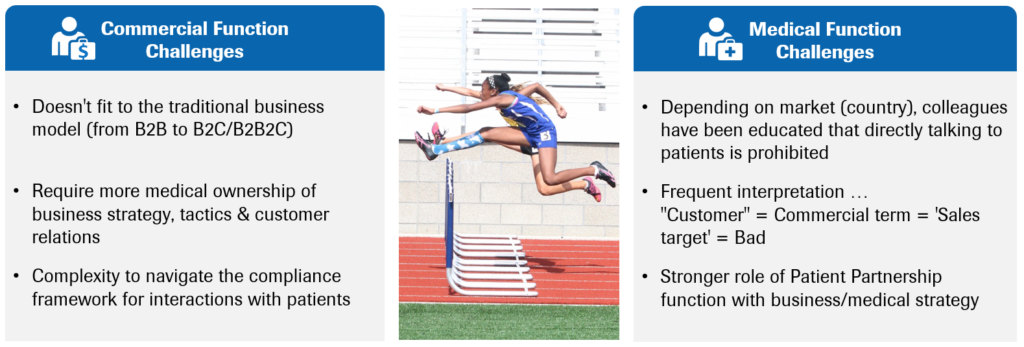I once joined the medical leadership team meeting of a major TA (therapeutic area) in my company. Not going to further disclose which and where and who, as it is not my intention to accidentally blame someone. And I am quite confident that the following conversation could have happened in every TA in every pharma company.
Back to the situation. I had not really finished introducing myself and my role as Global Head of Medical Customer Experience, when suddenly a question was thrown out of the group. “Okay, tell me! Who is the customer?”
I need to admit that it had been quite early in the morning (and I am definitely no early bird) and my brain wasn’t fully booted yet. But I instantly felt some unexpected ‘tension’ in the room that triggered a little flush of adrenaline, which itself pushed me up to full presence in trickles of a second.
And I heard myself saying … “The patient!”
Wow! You cannot imagine the energy that instantly filled this little meeting room. Obviously, they had just waited for that answer, finally allowing them to throw at someone all their concerns and troubles with – seriously – taking patients as customers, as the company expected them to. And I took it and stood it.
It had been a lot of hot discussion. As a little anecdote, I still remember someone pulling out her iPhone and checking Merriam-Webster’s Dictionary for the definition of what a customer is … ‘one that purchases a commodity or service’. And other colleague instantly jumping on it and the “unacceptable commercial concept on patients“. Where I felt obliged to ask back, “well, does the doctor pay for the treatment?” Which at least resulted in some calming-down and reflection that things might not be just black and white.
I am honest. The intense of the pushback had definitely surprised me. And some arguments shared by my partners in dispute were really new to me. The thinking around ‘customers being sales victims’ was so far away from my own thinking, so listening to it was truly eye-opening (see my article on “Why it is good being a customer” where I am following up on this particular one). So, with regard to an employees’ experience, the whole event turned out also being about ‘listening’ to each other.
By listening, I learned that adopting patients as customers is associated with challenges and hurdles for many colleagues, they might be in medical or commercial roles. Challenges with regard to mindset, but also challenges concerning reality of day-to-day business and ways of working, as shown in this overview …

Now, what is the good part of the story? Yes, it had been hard in the situation. But retrospectively I found it being a gift having the opportunity to controversially discuss why we should acknowledge patients as real customers. In addition, I myself learned a lot about where the (more subliminal) resistance that I was facing actually was coming from, and it helped me a lot to understand the other views better. Last not least, I could show up as a strong advocate with good arguments beyond the typical buzz-wording, which might potentially give others the inspiration that it could be worth thinking about it.
A few months later, when speaking at an industry conference, I was asked out of the audience, “but what can we do when facing individual and organizational resistance with taking patient centricity serious?“
My answer – based on what I learned at that TA leadership team meeting – was …
- tell your ‘patient = customer’ story, over and over again …. don’t be shy with talking and advocating, the way into brains goes via the ears, and repetition does the job
- learn to enjoy the controversial discussion … stand it!, every single one is an opportunity to listen & learn yourself as well as make others start thinking, this is where change begins
- changing minds is a marathon … don’t expect that people switch opinion overnight or just because you have explained them once, when you can’t hear it anymore … this will be the point when others begin to get it
And if you allow me to add personally … you are not alone! 😉
